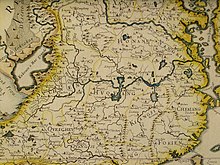
Hubei is a landlocked province of the People's Republic of China, and is part of the Central China region. The name of the province means "north of the lake", referring to its position north of Dongting Lake. The provincial capital, Wuhan, serves as a major transportation hub and the political, cultural, and economic hub of central China.

Wuchang forms part of the urban core of and is one of 13 urban districts of the prefecture-level city of Wuhan, the capital of Hubei Province, China. It is the oldest of the three cities that merged into modern-day Wuhan, and stood on the right (southeastern) bank of the Yangtze River, opposite the mouth of the Han River. The two other cities, Hanyang and Hankou, were on the left (northwestern) bank, separated from each other by the Han River.
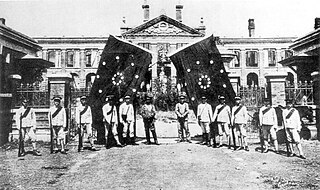
The Wuchang Uprising was an armed rebellion against the ruling Qing dynasty that took place in Wuchang, Hubei, China on 10 October 1911, beginning the Xinhai Revolution that successfully overthrew China's last imperial dynasty. It was led by elements of the New Army, influenced by revolutionary ideas from Tongmenghui. The uprising and the eventual revolution directly led to the downfall of the Qing dynasty with almost three centuries of imperial rule, and the establishment of the Republic of China (ROC), which commemorates the anniversary of the uprising's starting date of 10 October as the National Day of the Republic of China.

Dongting Lake is a large, shallow lake in northeastern Hunan Province, China. It is a flood basin of the Yangtze River, so its volume depends on the season. The provinces of Hubei and Hunan are named after their location relative to the lake: Hubei means "North of the Lake" and Hunan, "South of the Lake".

Jiangnan, also romanized as Kiangnan, Chiang-nan, and Jiang Nan, is a geographic area in China referring to lands immediately to the south of the lower reaches of the Yangtze River, including the southern part of its delta. The region encompasses the city of Shanghai, the southern part of Jiangsu Province, the southeastern part of Anhui Province, the northern part of Jiangxi Province and the northern part of Zhejiang Province. The most important cities in the area include Anqing, Changzhou, Hangzhou, Nanjing, Ningbo, Shaoxing, Suzhou, Wuxi, Wenzhou, Yangzhou and Zhenjiang.
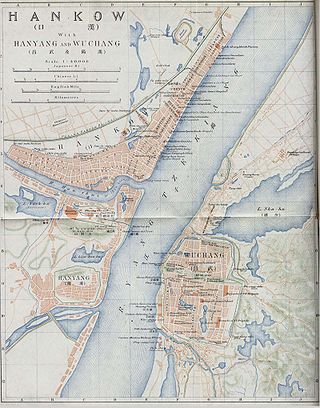
Hankou, alternately romanized as Hankow, was one of the three towns merged to become modern-day Wuhan city, the capital of the Hubei province, China. It stands north of the Han and Yangtze Rivers where the Han flows into the Yangtze. Hankou is connected by bridges to its triplet sister towns Hanyang and Wuchang.

Xiangxi Tujia and Miao Autonomous Prefecture is an autonomous prefecture of the People's Republic of China. It is located in northwestern Hunan province. It consists of one city, Jishou, and seven counties: Baojing, Fenghuang, Guzhang, Huayuan, Longshan, Luxi, Yongshun. Jishou is the capital. Of the 2,480,000 residents, 66.6% are ethnic minorities from 25 different ethnic groups, including 860,000 Tujia and 790,000 Miao.
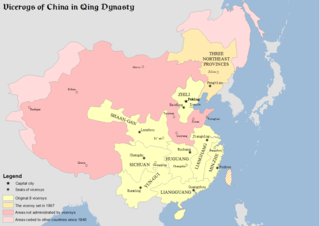
Zongdu, usually translated as Viceroy, Head of State or Governor-General, governed one territory or more provinces of China during the Ming and Qing dynasties.

Zhang Xianzhong, nickname Huanghu, was a Chinese peasant leader who led a peasant revolt from Yan'an wei, Shaanxi. He conquered Sichuan in 1644, and named himself king and later emperor of the Xi dynasty. His rule in Sichuan was brief, and he was killed by the invading Qing army. He is commonly associated with the massacres in Sichuan that depopulated the region. However, the extent of his killings is disputed.

Gao Lingwei ; (1870–1940) was a Chinese politician during the late Qing dynasty and the early Republic of China.
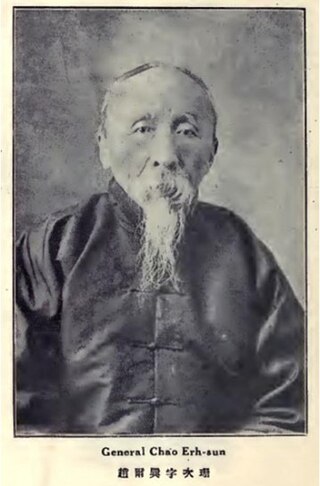
Zhao Erxun, courtesy name Cishan, art name Wubu, was a Chinese political and military officeholder who lived in the late Qing dynasty. He served in numerous high-ranking positions under the Qing government, including Viceroy of Sichuan, Viceroy of Huguang, and Viceroy of the Three Northeast Provinces. After the fall of the Qing dynasty, he became a historian and was the lead editor of the Draft History of Qing.

The Viceroy of Huguang, fully referred to in Chinese as the Governor-General of Hubei and Hunan Provinces and the Surrounding Areas; Overseeing Military Affairs, Food Production; Director of Civil Affairs, was one of eight regional Viceroys in China proper during the Qing dynasty. The Viceroy of Huguang had jurisdiction over Hubei and Hunan provinces, which were previously a single province called "Huguang Province" in the Ming dynasty, hence the name "Huguang".

The Viceroy of Sichuan, fully referred to in Chinese as the Governor-General of Sichuan Province and the Surrounding Areas Overseeing Military Affairs and Food Production, Director of Civil Affairs, was one of eight regional viceroys in China proper during the Qing dynasty. As its name suggests, the Viceroy of Sichuan had control over Sichuan (Szechuan) Province, as well as modern Chongqing Municipality, which was split off in 1997.
Jingzhou or Jing Province was one of the Nine Provinces of ancient China referenced in Chinese historical texts such as the Tribute of Yu, Erya and Rites of Zhou.
Yangzhou, Yangchow or Yang Province was one of the Nine Provinces of ancient China mentioned in historical texts such as the Tribute of Yu, Erya and Rites of Zhou.
Late Qing reforms, commonly known as New Policies of the late Qing dynasty, or New Deal of the late Qing dynasty, simply referred to as New Policies, were a series of cultural, economic, educational, military, diplomatic, and political reforms implemented in the last decade of the Qing dynasty to keep the dynasty in power after the invasions of the great powers of the Eight Nation Alliance in league with the ten provinces of the Southeast Mutual Protection in the Boxer Uprising.

The Yuan dynasty was a Mongol-led imperial Chinese dynasty. During its existence, its territory was divided into the Central Region (腹裏) governed by the Central Secretariat and places under control of various provinces (行省) or Branch Secretariats (行中書省), as well as the region under the Bureau of Buddhist and Tibetan Affairs. In addition, the Yuan emperors held nominal suzerainty over the western Mongol khanates, but in reality none of them were governed by the Yuan dynasty due to the division of the Mongol Empire.

Jiangnan, formerly romanized as Kiangnan, was a historical province of the early Qing Empire. Its capital was Jiangning, from which it is sometimes known as Nanjing or Nanking Province. Established in 1645 during the Manchu conquest of Ming China, it administered the area of the earlier Ming province of Nanzhili, reaching from north of the Huai River—at the time the course of the Yellow River—to south of the Yangtze River in East China. Its territory was later divided into the separate provinces of Jiangsu and Anhui during the reign of the Qianlong Emperor (1736–1795), although the exact timing is disputed. Under the Republic and People's Republic of China, an area of Jiangsu also became the provincial-level municipality of Shanghai.
The prefecture-level city of Wuhan, the capital city of Hubei province, China, has a long and rich history that dates back over 3,500 years. Starting out from the Shang dynasty-era archaeological site at Panlongcheng associated with Erligang culture, the region would become part of the E state and Chu state during the Zhou dynasty. The region evolved into an important port on the middle reaches of the Yangtze River, and the cities of Hanyang, Hankou and Wuchang were united into the city of Wuhan in 1926. Wuhan briefly serving as the capital city of China in 1927 and in 1937. Modern-day Wuhan is known as 'China's Thoroughfare' (九省通衢) due to its status as a major transportation hub, with dozens of railways, roads and expressways passing through the city and connecting to other major cities.
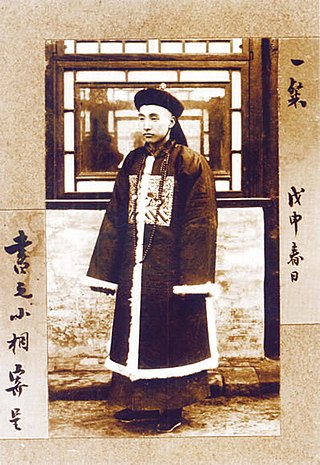
The early Qing emperors adopted the bureaucratic structures and institutions from the preceding Ming dynasty but split rule between the Han and Manchus with some positions also given to Mongols. Like previous dynasties, the Qing recruited officials via the imperial examination system until the system was abolished in 1905. The Qing divided the positions into civil and military positions, each having nine grades or ranks, each subdivided into a and b categories. Civil appointments ranged from an attendant to the emperor or a Grand Secretary in the Forbidden City (highest) to being a prefectural tax collector, deputy jail warden, deputy police commissioner, or tax examiner. Military appointments ranged from being a field marshal or chamberlain of the imperial bodyguard to a third class sergeant, corporal or a first or second class private.
